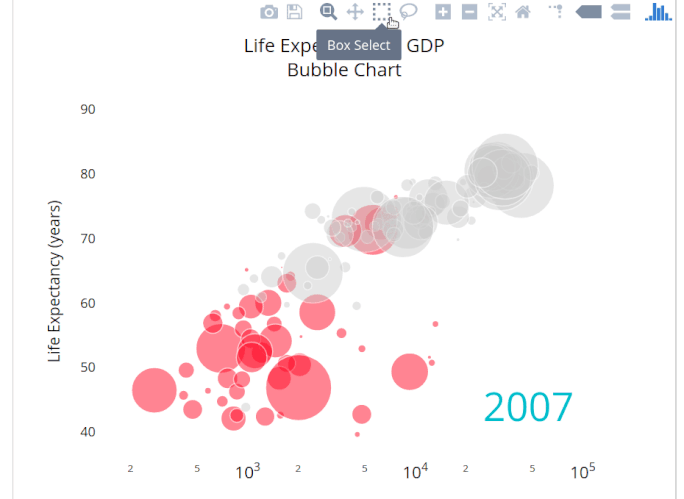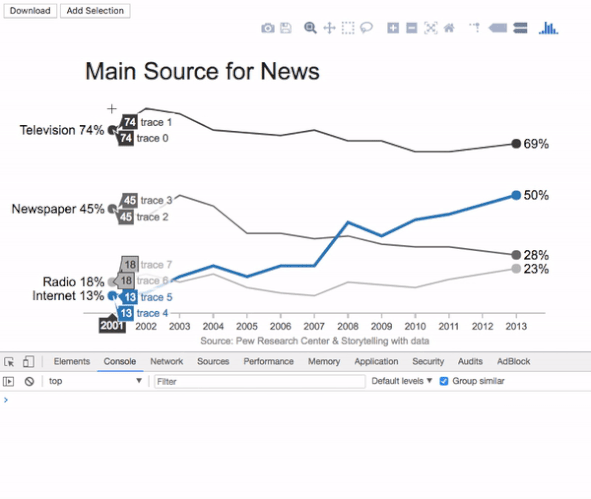I’m experimenting with the plotly_selected event and I’m encountering a few problems.
My goal is to allow the user to select a portion of the plot and then they can press a button to export that data into as a plot in a separate div. The plotly_selected section of my code below is based on the Lasso Example, so I know that there will be problems with the way I’m attempting to replot the data.
The graphDiv.on(‘plotly_selected’…) section never gets called.
<!DOCTYPE html>
<html lang="en">
<head>
<!-- Plotly.js -->
<script src="https://cdn.plot.ly/plotly-latest.min.js"></script>
</head>
<body>
<div>
<button onclick="downloadMainPlot()">Download</button>
<button onclick="addSelection()">Add Selection</button>
</div>
<div id="graph">
<!-- Plotly chart will be drawn inside this DIV -->
</div>
<div id="selectedPlots">
<!-- All confirmed selections will be drawn inside this DIV -->
</div>
<script>
var graphDiv = document.getElementById('graph');
var xData = [
[2001, 2002, 2003, 2004, 2005, 2006, 2007, 2008, 2009, 2010, 2011, 2013],
[2001, 2002, 2003, 2004, 2005, 2006, 2007, 2008, 2009, 2010, 2011, 2013],
[2001, 2002, 2003, 2004, 2005, 2006, 2007, 2008, 2009, 2010, 2011, 2013],
[2001, 2002, 2003, 2004, 2005, 2006, 2007, 2008, 2009, 2010, 2011, 2013]
];
var yData = [
[74, 82, 80, 74, 73, 72, 74, 70, 70, 66, 66, 69],
[45, 42, 50, 46, 36, 36, 34, 35, 32, 31, 31, 28],
[13, 14, 20, 24, 20, 24, 24, 40, 35, 41, 43, 50],
[18, 21, 18, 21, 16, 14, 13, 18, 17, 16, 19, 23]
];
var colors = ['rgba(67,67,67,1)', 'rgba(115,115,115,1)', 'rgba(49,130,189, 1)',
'rgba(189,189,189,1)'
];
var lineSize = [2, 2, 4, 2];
var labels = ['Television', 'Newspaper', 'Internet', 'Radio'];
var data = [];
for (var i = 0; i < xData.length; i++) {
var result = {
x: xData[i],
y: yData[i],
type: 'scatter',
mode: 'lines',
line: {
color: colors[i],
width: lineSize[i]
}
};
var result2 = {
x: [xData[i][0], xData[i][11]],
y: [yData[i][0], yData[i][11]],
type: 'scatter',
mode: 'markers',
marker: {
color: colors[i],
size: 12
}
};
data.push(result, result2);
}
var layout = {
showlegend: false,
xaxis: {
showline: true,
showgrid: false,
showticklabels: true,
linecolor: 'rgb(204,204,204)',
linewidth: 2,
autotick: false,
ticks: 'outside',
tickcolor: 'rgb(204,204,204)',
tickwidth: 2,
ticklen: 5,
tickfont: {
family: 'Arial',
size: 12,
color: 'rgb(82, 82, 82)'
},
// Can't use because it limits the option to view specific portions. Forces user to view all of y-axixs
// rangeslider: {}
},
yaxis: {
showgrid: false,
zeroline: false,
showline: false,
showticklabels: false,
// Forces user to view all of y-axis on selection
// rangeslider: {}
},
autosize: false,
margin: {
autoexpand: false,
l: 100,
r: 20,
t: 100
},
annotations: [
{
xref: 'paper',
yref: 'paper',
x: 0.0,
y: 1.05,
xanchor: 'left',
yanchor: 'bottom',
text: 'Main Source for News',
font: {
family: 'Arial',
size: 30,
color: 'rgb(37,37,37)'
},
showarrow: false,
},
{
xref: 'paper',
yref: 'paper',
x: 0.5,
y: -0.1,
xanchor: 'center',
yanchor: 'top',
text: 'Source: Pew Research Center & Storytelling with data',
showarrow: false,
font: {
family: 'Arial',
size: 12,
color: 'rgb(150,150,150)'
}
}
]
};
for (var i = 0; i < xData.length; i++) {
var result = {
xref: 'paper',
x: 0.05,
y: yData[i][0],
xanchor: 'right',
yanchor: 'middle',
text: labels[i] + ' ' + yData[i][0] + '%',
showarrow: false,
font: {
family: 'Arial',
size: 16,
color: 'black'
}
};
var result2 = {
xref: 'paper',
x: 0.95,
y: yData[i][11],
xanchor: 'left',
yanchor: 'middle',
text: yData[i][11] + '%',
font: {
family: 'Arial',
size: 16,
color: 'black'
},
showarrow: false
};
layout.annotations.push(result, result2);
}
Plotly.newPlot(graphDiv, data, layout, { displayModeBar: false });
function downloadMainPlot() {
Plotly.downloadImage(graphDiv, { format: 'png', width: 800, height: 600, filename: 'newplot' });
}
var selectCount = 0;
function addSelection() {
var newSelect = document.createElement('DIV');
var newID = 'plot' + selectCount.toString();
newSelect.setAttribute("id", newID);
document.getElementById('selectedPlots').appendChild(newSelect);
console.log('y');
graphDiv.on('plotly_selected', function (eventData) {
var x = [];
var y = [];
console.log(eventData)
eventData.points.forEach(function (pt) {
x.push(pt.x);
y.push(pt.y);
});
layout.annotations.text = "New Plot #" + selectCount.toString();
Plotly.newPlot(
document.getElementById(newID),
{
x: x,
y: y,
},
layout,
{
displayModeBar: false
}
);
});
newSelect = null;
selectCount++;
}
</script>
</body>
</html>
If I remove the on.(‘plotly_selected’…); section from the function and place it with everything else it still doesn’t get called.
Advice?
Notes:
- The data used in the plot came from a random example I found through the plot.ly community
- I even tried plotly_slected (there’s a typo in the Select-Event documentation).

